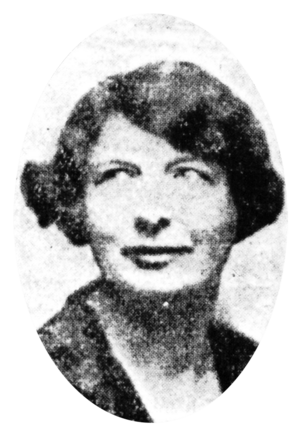Margaret Buckley facts for kids
Margaret Buckley (born Margaret Goulding; July 1879 – 24 July 1962) was a very important Irish woman who fought for Ireland's independence. She led a political party called Sinn Féin from 1937 to 1950. She was the first woman ever to lead Sinn Féin, and also the first Irish woman to lead any political party!
Quick facts for kids
Margaret Buckley
|
|
|---|---|
 |
|
| President of Sinn Féin | |
| In office 1937–1950 |
|
| Preceded by | Cathal Ó Murchadha |
| Succeeded by | Paddy McLogan |
| Vice President of Sinn Féin | |
| In office 1933–1937 |
|
| In office 1952–1960 |
|
| Personal details | |
| Born | 26 July 1879 Cork, Ireland |
| Died | 24 July 1962 (aged 82–83) |
| Resting place | St. Finbarr's Cemetery, Cork, Ireland |
| Political party | Sinn Féin |
Contents
Early Life and Activism
Margaret Buckley was born in Cork, Ireland, in July 1879. Her parents were James Goulding and Ellen Foyle. From a young age, Margaret became involved in important movements for change in Ireland.
Joining the Women's Movement
In 1900, Margaret joined a group called Inghinidhe na hÉireann (Daughters of Ireland). This group was very active in the women's movement, working for women's rights and for Ireland's independence. Margaret was a strong supporter of these causes.
Early Protests and Marriage
Margaret took part in protests against British royal visits to Ireland in 1903 and 1907. She also helped start a group called An Dún in Cork in 1910. In 1906, she married Patrick Buckley. After he passed away, she moved to Dublin, but later returned to Cork to care for her father.
Fighting for Independence
Margaret Buckley played a brave role in Ireland's fight for independence. She faced many challenges and even spent time in prison for her beliefs.
After the Easter Rising
After the Easter Rising in 1916, Margaret was arrested. She was later released in June 1917. After her release, she worked hard to help reorganize Sinn Féin, a political party that wanted Ireland to be independent. She was also involved in the Irish War of Independence in Cork.
Becoming a Judge
After her father died, Margaret moved back to Dublin. In 1920, she became a judge in the Dáil Courts. These were special courts set up by the Irish Republic during the War of Independence. She was appointed by Austin Stack, who was like the Minister for Justice at the time.
Imprisonment and Hunger Strike
Margaret did not agree with the Anglo-Irish Treaty, which created the Irish Free State but kept Ireland linked to Britain. Because of her opposition, she was taken to prison in Mountjoy Jail and Kilmainham Jail. While in prison, she bravely went on a hunger strike, refusing to eat to protest her imprisonment. She was released in October 1923.
During her time in prison, Margaret was a leader among the other republican prisoners. She was the Officer Commanding (OC) in Mountjoy and Kilmainham, meaning she was in charge of the prisoners in those sections. She was also an active member of the Women Prisoners' Defence League, a group founded by Maud Gonne and Charlotte Despard to support women prisoners.
Supporting Workers
Besides her political work, Margaret Buckley was also an organizer for the Irish Women Workers' Union. This shows her dedication to improving the lives of working women in Ireland.
Leading Sinn Féin
Margaret Buckley made history when she became the leader of Sinn Féin.
Becoming President
In October 1934, Margaret was chosen as one of Sinn Féin's vice-presidents. Just three years later, in 1937, she became the President of Sinn Féin. She took over from Cathal Ó Murchadha. This was a huge moment because Margaret Buckley was the first Irish woman to ever lead a political party!
Challenges as Leader
When Margaret became president, Sinn Féin was not working closely with the Irish Republican Army (IRA). The IRA had stopped its connection with the party in 1925. By the time Margaret left office in 1950, the relationship between Sinn Féin and the IRA had improved.
As President, Margaret also started a legal case called Buckley v. Attorney-General. This case was about money that Sinn Féin had raised before 1922. The party wanted to be recognized as the owners of this money, but they were not successful in court.
Writing Books
Margaret Buckley also shared her experiences and knowledge through writing. In 1938, she published her book The Jangle of the Keys. This book was about the experiences of Irish Republican women who were held in prison by the Irish Free State. Later, in 1956, her book Short History of Sinn Féin was published.
Later Years
Margaret Buckley remained active in Sinn Féin even into her late seventies. From 1950 until her death in 1962, she served as an honorary vice-president of the party. She was so respected that she was the only member of the party's leadership not arrested during a police raid in July 1957.
Margaret Buckley passed away on 24 July 1962. She is buried in St. Finbarr's Cemetery in Cork, Ireland.
Sources
- "Margaret Buckley, president of Sinn Féin", Saoirse Irish Freedom, July 1998.
| Party political offices | ||
|---|---|---|
| Preceded by Mary MacSwiney |
Vice President of Sinn Féin 1933–1935? |
Succeeded by ? |
| Preceded by Cathal Ó Murchadha |
President of Sinn Féin 1937–1950 |
Succeeded by Paddy McLogan |
| Preceded by Criostóir O'Neill |
Vice President of Sinn Féin 1950–1952 With: Michael Traynor |
Succeeded by Tomás Ó Dubhghaill |
| Preceded by Tomás Ó Dubhghaill |
Vice President of Sinn Féin 1954–1960 With: Tomás Ó Dubhghaill |
Succeeded by Tomás Ó Dubhghaill |

